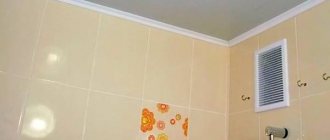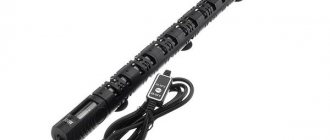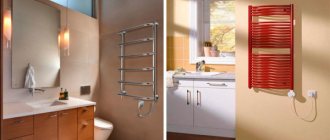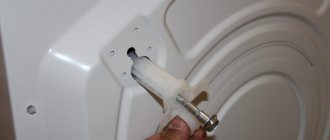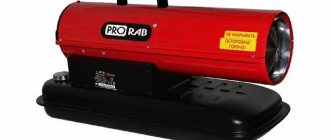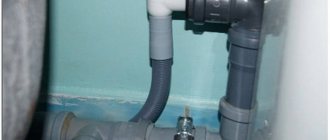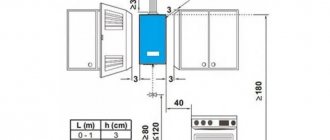How does the air exchange problem occur?
In modern multi-storey buildings, forced ventilation is installed at the design and construction stage. The draft is created by a powerful fan installed on the technical floor or on the roof. Residents are not required to install additional equipment in apartments.
In most apartment buildings, ventilation is arranged differently.
Air flows in the exhaust ventilation of an apartment building
In the walls separating the apartments from the entrance there is a ventilation shaft with openings leading into the living quarters. The air flow to extract odors and moisture is created by the difference in temperature and atmospheric pressure on the first floors and on the roof. The air flow rises up, sucking in the smells of their toilet, bath and kitchen. The flow of fresh air into the apartment occurs through loosely fitted wooden window frames, vents, entrance doors, and in modern houses through valves in plastic windows.
The human factor interferes with the proper operation of ventilation:
- Clogging or blocking of ventilation ducts during construction (repair) work;
- Installation of cheap plastic windows without supply valves;
- Installation of doors with seals;
- Placement of powerful hoods by neighbors at the entrance, disturbing the balance of air flows;
- Rare preventative cleaning of ventilation shaft ducts by the management company.
Insufficient ventilation results in:
- Increased humidity in the premises;
- The appearance and proliferation of mold and mildew are the causes of dangerous allergic diseases. The finish quickly takes on an unsightly appearance;
- In severe cases, reverse draft appears, and odors from the mine enter the living space.
Mold on the ceiling due to insufficient ventilation
Installing exhaust fans in the bathroom is one way to solve the problem. Often, coming to an agreement with all the neighbors and returning the ventilation to its original form is a difficult task.
How to check traction
You can check the draft from the apartment in two ways:
- The door to the bathroom is opened, and a lit lighter or match is brought to the ventilation hole. If the flame leans noticeably towards the hole, there is draft.
Checking draft with a lighter
- An unfolded napkin is brought to the ventilation hatch. If it is attracted and stays on the hole, there is also traction.
Important! When checking the draft, the sealed bathroom door must be open. This will ensure a natural flow of air from other rooms in the apartment.
Types of bathroom ventilation
Room ventilation parameters are regulated by the current SNiP 41–01–2003. The standard prescribes several types of ventilation and air exchange rates.
SNiP 41-01-2003. Heating, ventilation and air conditioning
SNiP 41–01–2003
Ventilation can be of two types.
Natural
Using special openings in bathrooms, fresh air is supplied and exhaust air is removed. The exchange occurs due to the pressure difference - warm air from the room rises and is released into the atmosphere through ventilation ducts. Fresh air enters from below through openings in the door. The dimensions of the holes are calculated taking into account the climatic zone of the buildings, the volume of the room and the frequency of exchange. In bathrooms, the air should be changed 6-8 times per hour.
Natural ventilation in the bathroom
The advantages of such a system are simplicity and autonomy of operation.
Disadvantages - greater dependence on weather conditions, the likelihood of reverse draft. The air is not drawn out of the room, but forced. As a result of this phenomenon, the humidity in all rooms increases.
High humidity causes mold and mildew
Another drawback is large heat losses. In the context of constantly rising energy prices, the costs of maintaining premises are increasing. Homeowners are trying to reduce losses using various methods. This must be done skillfully; as a result of unprofessional intervention, instead of the desired savings, you can get serious losses. The walls and ceilings of the bathrooms will have to be repaired.
Forced
Ventilation diagram
Fans are used to supply/extract air. An exhaust fan for a bathroom removes air only during a given period of time or at certain air humidity values (depending on the type and capabilities of the device); the supply of fresh air is ensured by special vents. According to the method of supplying or extracting air, forced ventilation can be exhaust, supply or supply and exhaust. If the fan only removes air, the system is forced exhaust; if it only pumps air, the system is forced supply. If there are two fans, one of which supplies and the second removes, then the system is called supply and exhaust.
The use of a forced ventilation system for a bathroom makes it possible to achieve regulated humidity values with minimal heat loss. Which type of ventilation to choose depends on the capabilities and wishes of the apartment owner and the architectural features of the building.
Ventilation in the bathroom
Types of bathroom fans
In bathrooms, three types of devices are used based on the principle of operation:
- axial;
- centrifugal;
- combined.
Axial
Air flows in this type of device are moved by the rotation of impeller blades, similar to a propeller or an airplane propeller. The air moves along the axis of the electric motor, thereby cooling the motor.
Axial fans for hoods
Advantages of axial fans:
- low noise level during operation, since the design allows for precise balancing of parts;
- efficiency.
Basically, the range is designed for small or medium-sized bathrooms. The housings of household appliances are made of plastic, which allows them to be given designer shapes. The parts do not require anti-corrosion protection.
The use of axial fans in domestic conditions is limited by low air exchange performance and efficiency, which does not allow the device to be used in large rooms.
Important! The air flow creates turbulence - this limits the length of the air ducts (if used). The length of the horizontal section of the ventilation duct should not exceed 2.5-3 meters.
Radial
The radial, or centrifugal, type is used for air exchange in large bathrooms and combined bathrooms.
The air flow in such devices moves in a direction transverse to the engine.
Radial fan design
The efficiency of centrifugal fans is higher than that of models of similar power axial devices. The productivity and efficiency of the devices is significantly higher. At the same time, complaints are often made against such models due to increased noise.
Important! The fans presented for sale comply with the parameters established by the noise rules, but in some cases it may disturb users.
Combined
Combined type devices combine in their design the principles of previously discussed devices, and, accordingly, their advantages and disadvantages.
When a hood in the bathroom is absolutely necessary
If there is no natural air ventilation in the bathroom, you cannot do without a fan. It is very easy to check the operation of natural hood. To do this, just bring a lit candle or match to the ventilation grille. If the flame is strong and reaches towards the grate, then everything is fine with ventilation. Otherwise, you should still invest in a bathroom fan.
Unfortunately, many are trying to solve this problem without extra costs. Namely, they try to keep the door to the bathroom open all the time. Of course, the humid air in this case leaves the bath, but in most cases it does not end up outside, as it should be, but in the rest of the rooms. So the problem just moves from one room to another.
How to choose according to technical parameters
Before going to a shopping center or online store, you need to decide on the fan parameters that will meet the requirements for use in a particular room.
Important device parameters:
- air exchange;
- maximum noise level.
Both characteristics usually depend on engine power.
Air exchange
Acceptable humidity in the room can be maintained if the air changes at a rate of 6-8 room volumes per hour, when using the bathroom with a family of 4 people.
You can find out the volume of a room by multiplying the geometric dimensions. A room of 2.2x2.5x2.7 m has a volume of 14.8 m³. Therefore, for an eight-fold air exchange, a device with a capacity of 120 m³ is suitable.
Attention! Fans provide air exchange only when the power supply is connected. When the network is turned off, the blades prevent air movement. The problem is eliminated by installing an exhaust device whose geometric size is smaller than the opening of the ventilation duct, or by leaving a gap between the wall and the housing.
Noise level
According to SanPin standards, in apartment buildings it is allowed to install devices with a noise level of up to 40 dB. The fan must meet these characteristics to avoid misunderstandings with neighbors and, first of all, for the comfortable rest of family members.
Power consumption
For large families, such a characteristic of the exhaust device as power consumption is important - after all, the fan will remain running for a long time. On average, fans with a capacity of up to 150 m3/hour consume from 10 to 25 W/hour. The characteristics can be found on the packaging and in the technical data sheets of the purchased devices.
What are there
All exhaust fans are divided according to several criteria:
- shape - round, square, rectangular;
- direction of air movement – supply and exhaust (into/out of the room);
- type of installation – channel and wall;
- operating mechanism - axial and centrifugal (radial).
The principle is the same for all - increased air injection into the ventilation system, but they differ in the nuances, and are installed in rooms for various purposes.
We recommend the product
Exhaust fan Soler&Palau Silent-100 CZ Design (5210601800) 6 reviews
In stock
Finish: glossy | Fan noise level, dB: 26.50 | Air consumption, m³/hour: 85 | Diameter, mm: 100 |
Additional options
It is important to consider additional functions when choosing a model.
Constant rotation mode
The mode in which the impeller rotates constantly is convenient for frequent use of the bathroom. In standby mode, the fan rotates at a slow speed, creating no noise and saving energy. Based on a signal from a hydrostat - built-in or external - productivity increases and air exchange accelerates.
Timer
An automatic switch (timer) is useful in a family with small children. The device will turn off the device after a specified time, and also will not allow the fan to work in an empty apartment.
Hydrostat
The humidity sensor automatically turns the hood on and off, maintaining optimal air humidity.
hydrostat (humidity sensor) automatically turns the fan on and off to maintain optimal humidity levels;
Motion Sensor
The device automatically turns on the fan while a person is present in the room. Often the option works in conjunction with a timer. In this case, the device will turn off after a specified time, after the room has become vacant.
Important! Most models allow you to set the delay time for timers and motion sensors manually. How to do this is written in the operating instructions.
Check valve in design - is it necessary or not?
Irregularities in the operation of ventilation lead to reverse draft - an unpleasant smell from the mine enters the premises of all apartments at the entrance. You can reduce the consequences by purchasing a fan with a check valve.
Check valve in fan
Depending on the control method, valves can be manual or automatic. The latter are considered more convenient - they block the exhaust hole immediately after the impeller stops rotating.
Additional functions
Among the huge variety of hoods, there are primitive models without additional features, as well as more advanced devices. A standard fan starts functioning immediately after turning on the light in the bathroom, and stops when turned off. The most useful functions are the following:
- A timer is usually built into automatic hoods, and after the lights are turned off, the device continues to operate for the specified time. This allows for better ventilation of the room, eliminates the need to leave the lights on, and saves energy. Some models have a display showing the time and percentage of humidity in the bathroom.
- Motion sensors are triggered when a person enters the bathroom. The function is not built into every model, but it greatly simplifies the operation of the device.
- The indicator light makes using the device more enjoyable. A special light comes on when the fan is turned on. But such devices consume more energy.
- Automatic closing of the blinds will prevent the room from cooling after the device is turned off. Typically, the function is needed when installing a duct hood, the air hose of which goes directly into the ventilation shaft.
- A check valve is also necessary in a duct-type hood; closing it eliminates the possibility of foreign unpleasant odors from entering the bathroom or toilet from the ventilation shaft.
Automatic model with a display showing the set time and humidity level
A device with several additional functions will cope with ventilation better and will be much easier to manage. But it is worth remembering that such a device is more energy-consuming.
Exhaust hood in the bathroom and toilet is an important element of the arrangement of the room, which allows you to eliminate the formation of mold, mildew, and prevent the development of microbes. With the correct selection of devices, the surfaces of the bathroom will not be constantly exposed to moisture, which will extend their service life.
Silent fan design
The reasons for loud fan operation are the movement of air flow, noise from rotating mechanisms, and improper installation of the device.
The faster the air flow, the louder the sound accompanying this process will be.
Important! Use fans whose outlet openings are similar in size to the shape of the exhaust ducts. A large selection of equipment in stores helps to do this.
In the electrical appliance itself, the motor, housing parts, and bearings make noise.
When choosing a device, pay attention to the reliability of the motor mounting and the presence of rubber bushings at the installation sites.
When examining the body, preference is given to models in which it is solid. The minimum number of parts is an advantage when purchasing.
Products from branded manufacturers are equipped with ball bearings, which are silent during operation. In cheap models, the impeller shaft rotates in plain bearings - bronze or brass bushings. This design quickly leads to vibrations and noises that gradually become unbearable.
Important! Fans for installation on horizontal surfaces are equipped with thrust bearings that are resistant to forces applied in all planes.
Rating of manufacturing companies
Among the manufacturers of exhaust hood equipment for individual housing, the leading companies are:
- Motors JSC. Bulgaria;
- Era LLC, Russia;
- Soler & Palau, Spain;
- Elicent, Italy;
- CATA Electrodomesticos SL, Spain.
Top selling models
In small and medium-sized bathrooms, axial-type models are installed - low noise and energy efficient.
| Model | Noise, dB | Productivity, m3/h | Power | Possible additional options (see model description) | Average price, rub. |
| SILENT-100 CZ | 26,5 | 95 | 8 | Check valve, ball bearings, cord switch, timer, hydrostat. | 2000 |
| Elicent E - Style 100 PRO | 32 | 95 | 14 | Check valve | 1500 |
| Motors mm-100 | 36 | 60 | 16 | Check valve. | 2100 |
| Electrolux Rainbow EAFR-100 | 33 | 70 | 15 | Check valve, bearing. | 3000 |
| Soler&Palau SILENT 100 DESIGN 3C | 25 | 95 | 8 | Timer, bearing, check valve | 5000 |
Powerful fans for a large bathroom
To maintain humidity in a large bathroom, powerful fans are suitable.
Model Standard 4ETF
The Standard 4ETF model, Era LLC, is capable of providing air exchange up to 100 m³/hour. There is a built-in photo timer that is triggered by turning on the light in the bathroom.
Electrolux Premium EAF-150 is a device with a capacity of up to 320 m³/hour. 25 W motor. Installation in any plane is possible. The noise level of 35 dB is due to the installation of a powerful engine, which, however, is compensated by the short air purification time when turned on.
EBB-250 NS, manufacturer Soler & Palau. Centrifugal type of devices for large-volume bathrooms and combined bathrooms. Two-speed motor, air exchange up to 270 m³/hour.
WHY DO YOU NEED AN EXHAUST FAN?
Removing water vapor and, accordingly, reducing air humidity is the main reason why it is necessary to install an exhaust fan in bathrooms.
High air humidity can cause: wet spots on walls, floors and ceilings, corrosion (rusting) of metals, the appearance and development of mold and mildew, peeling and destruction of decorative coatings (paint, wallpaper, tiles), the appearance of condensation, fogging of glass and many other unpleasant events. Also, the use of exhaust fans in a bathroom or toilet has a number of other positive aspects, such as removing unpleasant odors, improving air circulation, etc.
Natural ventilation, through door cracks or a ventilation duct, cannot always cope with this task effectively, so I advise everyone to install forced ventilation in bathrooms - exhaust fans.
Which model to buy
Reminder for choosing an exhaust fan (what to look for):
- Correspondence of the air exchange characteristics to the size of the bathroom;
- Selection of model according to installation location (duct, ceiling, overhead);
- Match the size of the fan outlet to the size of the hole in the wall;
- Positive customer reviews on the Internet;
- The build quality and noise level can be assessed at a stand in a shopping center.
In a hardware store, models are displayed on display racks where you can see them in action. If the exhibition copy is noisy or vibrates strongly, refuse to purchase. Check the build quality of the device - there should be no noticeable play in the fastening of all parts.
Duct hole size
The first step is to decide on the size of the hole itself. This is important because it will house the exhaust fan. If the dimensions do not match, the device will not fit into the shaft and will not work effectively. In addition, the external mesh will stick out, spoiling the interior.
There are three standard sizes of exhaust devices:
- 100 mm;
- 120 mm;
- 150 mm.
For the shaft opening, you will choose equipment from the options presented. The fans themselves can be installed in a false ceiling or on a wall, depending on the location of the air duct and the layout features. At the same time, take into account the installation depth of the device so that it fits into the hole without any problems and is securely fixed there. The choice of an exhaust fan and its subsequent operation largely depend on this.
How to install correctly
Productivity, efficiency and noise during operation depend on the correct installation of the exhaust device.
Installation in channels
Often, apartments of modern construction are equipped with ventilation ducts for ventilation of all rooms. Replacing and installing an exhaust fan in such cases is not difficult. Measure the diameter or geometric dimensions of the air duct and select the appropriate fan, which is secured using the clamps included in the kit.
Duct fan installation
Installation in exhaust openings
For installation in exhaust hatches you will need:
- fan;
- drill with drill bits for concrete;
- self-tapping screws with dowels;
- silicone sealant;
- electrical wires and switch;
- Screwdriver Set;
- ladder.
The work is performed in the following sequence:
- Prepare a ventilation hole. Dismantle the old decorative grille. Clean the installation site from dust, dirt and the wall around the hatch. Free the hole from foreign objects, remove fatty deposits and dirt to the possible depth.
Prepared location for fan installation
- Expand the seat using a perforator or reduce it using an alabaster (gypsum) solution, bringing the dimensions as close as possible to the fan outlet.
- If the size of the opening allows, use a device with an additional grille through which the exhaust occurs even when the power supply is turned off.
- Connect the electrical wiring.
Important! The bathroom is a high-risk room. The wiring is carried out in grooves or dielectric cable channels.
Fan installation
Fan installation algorithm:
- Remove the front panel from the device. Under it you can see holes for mounting on the surface and terminals for connecting the power supply.
Fan with cover removed, mounting holes and terminals visible
- Mark the holes for fastening.
- Drilling the walls (suspended ceiling).
Important! To drill ceramic tiles, special drills for ceramics and glass are used. The impact mode on a rotary hammer (drill) is not turned on. This will prevent the enamel from chipping.
The use of mounting adhesive is not advisable - during repairs it will be impossible to remove the fan without damaging the housing.
- Before installing the joints, it is recommended to treat them with silicone sealant with antimicrobial and anti-mold additives.
- After connecting the power, install a decorative grille.
